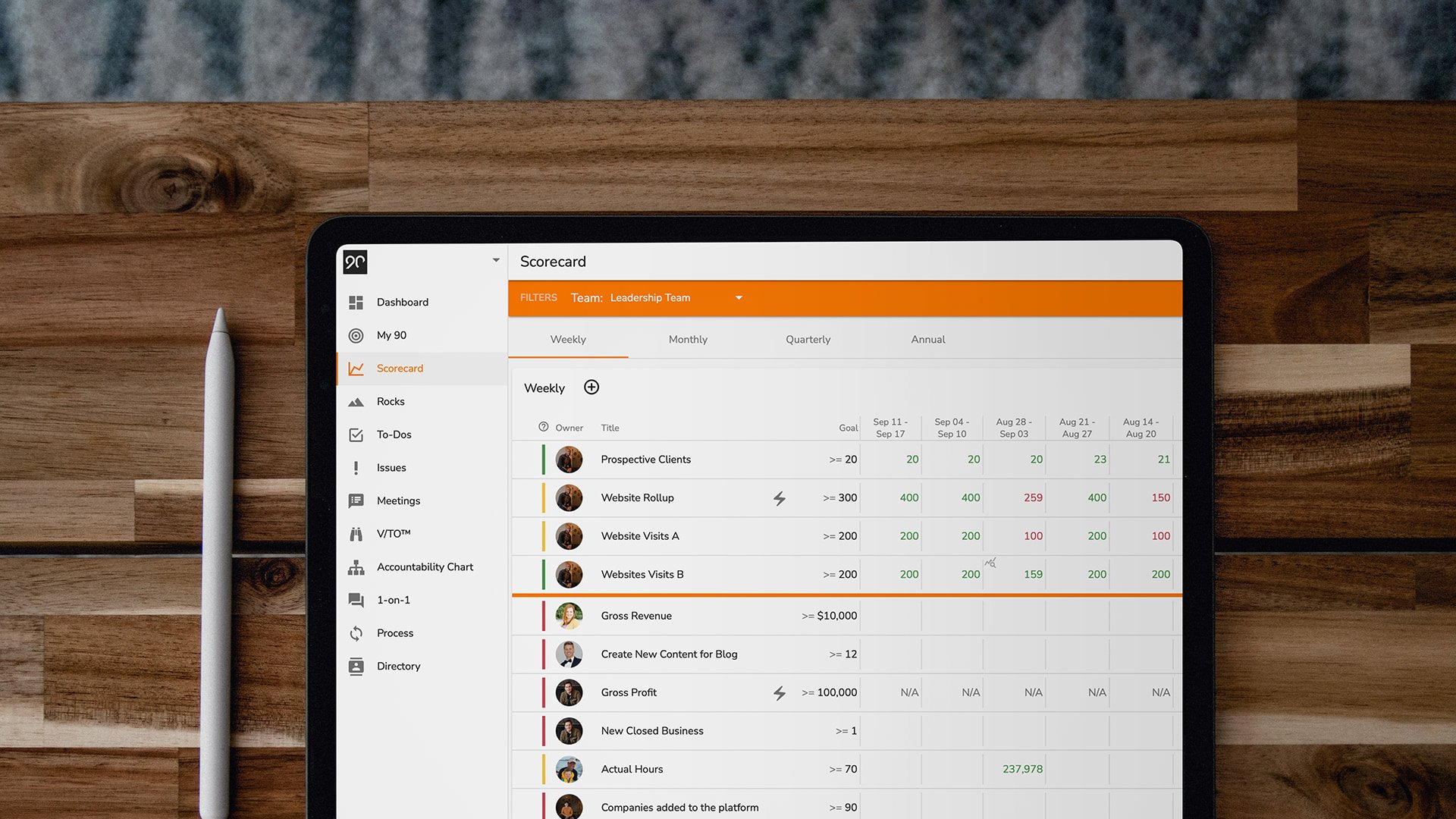EOS Scorecard™: Make Data Your Superpower
Business owners are always looking for ways to streamline performance tracking and drive success. But with so many data points to consider and different tracking systems at your disposal, the process can get unwieldy and overwhelming. The Scorecard in the Data Component™ of the EOS Model® is a simple but powerful tool to gauge whether your business is on or off track.
The EOS Scorecard provides clarity, focus, and accountability. It’s a clear snapshot of your company's performance so you can spot trends, address issues promptly, and align your team with your goals. It's not just about numbers; it's about accountability, continuous improvement, and winning. We know that what gets measured gets done.
In this post, we'll guide you through systematically strengthening the EOS Scorecard for your business success.
What Is the EOS Scorecard?
At its very core, the EOS Scorecard is designed to measure business performance and promote team accountability. It contains 5–15 activity-based numbers, called Measurables.
This powerful tool is also powerfully simple. It has four key columns: The first is the what, or the number. The second is the who, the person who owns or drives the number. Next is the goal for the week, and the fourth is the date, or the thirteen weeks for the quarter.
We love to see the patterns or trends because they bring visibility and an opportunity to fix what’s not working. If the number is off track, we “drop it down” to the Short-Term Issues list and IDS® (Identify, Discuss, and Solve) when we get to that section of our Level 10 Meeting™. Teams who get this discipline love that we're focused on advancing or fixing what’s off rather than just endlessly talking about it.
How to Build an Effective Scorecard
How do you know if you have the right Scorecard and that it’s working? It’s simple: when you have the right Scorecard, you’ll objectively know if you’re doing the work outlined in The Accountability Chart™, your manager will know the work you’ve accomplished, and the team will know if we have been on or off track.
In your Vision/Traction Organizer® (V/TO®), you set quarterly and annual goals for revenue, profit, and other key numbers. And if we’re doing the right work and measuring it through our Scorecard(s), then the result should be the attainment of these goals every 90 days.
So let’s build a Scorecard:
- Identify activity-based key metrics and mission-critical numbers that impact our progress. Less is more until it’s not, but far too many teams focus on trying to have “more” than less. Each department leader will typically own 1–3 Measurables, and since the Senior Leadership Team often has 5 people in it, we see 5–15 Measurables in the Scorecard. Simply ask each leader to identify the numbers that they work on weekly.
- Look for the learning and don’t be afraid to IDS on the Measurables until you get them right. Too often, teams hesitate to call an item off track and, instead, they look at an off-track scorecard and say “Next week will be better.” But it won’t be if we don’t do the work to learn about issues that are keeping it off track. Instead, enter the danger, IDS, and look for permanent solutions.
- Measurables are often linked to Core Processes because we need to know if they're struggling or off track. Every business has 8–14 Core Processes such as a hiring process or sales or marketing process. We just need to identify the numbers that govern the health of these processes and then add them to our Scorecard.
- Start with marketing or sales, especially if the team is feeling stuck. Since we’re looking for activity-based leading indicators, success begins by starting with the Funnel metrics since most organizations have these elements identified. Basically, in a sequence, how do we get more customers? Once we outline 1–3 of these Measurables, teams start to see other functional areas in a new light.
- Don’t worry about your industry until you’ve had lots of evolution on your Scorecard. EOS Implementers and Ninety are often asked for industry templates for Scorecards. While there are trends and patterns we see over time, the best way is to get started with your business. We aren’t inventing anything new; the answers are in the room, and you’re already doing the work. So let’s just measure it and build from there. Later on, as you get stronger in the tool, we can look to understand performance and industry comparables.
- Create an easy-to-read Scorecard using the EOS® Powered by Ninety platform. With our dynamic Scorecard tool, it’s easy to see current values, performance, trends, and more to guide weekly decisions and, when appropriate, course-correction issue-solving. The Scorecard should have one owner, and most of the time it’s the Integrator™ who is also your EOS Powered by Ninety champion.

We love the EOS disciplines Shared by All and Followed by All. With Ninety’s Scorecard, the entire team has access to update their Measurables from anywhere, anytime, so everyone can be ready for that weekly L10 meeting. One of our favorite features is the ability to click on the Measurable that is off track, then click again to make it an Issue waiting for us when we get to the IDS section of our Level 10 Meeting agenda.
Once your Company or Senior Leadership Team Scorecard becomes stronger, it will be time to roll out department Scorecards as well. Aim for 5–15 measurables depending on the size of the department, but keep it simple to see that we’re doing the weekly activities needed to be successful and have healthy team accountability.
Building an effective Scorecard takes time and practice; it won’t be perfect right out of the gate. But over time, you’ll find the rhythm for it and see how it drives improvement in your organization. Remember, as you hit your targets, be sure to celebrate these wins to motivate the team and further strengthen their resolve.
Harness the Power of the EOS Scorecard
You can implement your EOS Scorecard in Ninety in less than 15 minutes. That’s the fun work. The real work begins when you track your Measurables weekly, create a clear system of accountability, and bring the Scorecard into the Level 10 Meeting and IDS as a healthy team. Every day is a great day to start your journey with the EOS Toolbox™ Powered by Ninety.
Begin your free trial of Ninety and start gaining clarity, focus, and accountability — and most importantly, traction.





